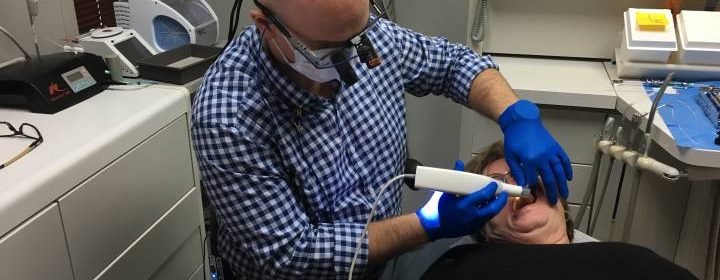Kelowna dentists turn to high-tech device to speed up, simplify dental restoration work

It’s technology that’s been around for some time, but it’s now starting to be used in the Okanagan.
Called the intraoral scanner, the device scans a patient’s teeth and creates a digital impression of them.
The intraoral scanner creates a 3D image of a patient\’s teeth.
“I am happy with the results, that’s the big thing for me,” said Dr. Darren Buschel of Springfield Dental Centre.
Buschel is one of the first Kelowna dentists to switch to the scanning device, which creates a 3D image of a patient’s teeth,
The digital creation of an exact replica of a patient’s mouth means dentists can skip the step of making a traditional impression, which requires patients to bite into a tray of silicone-type material.
“We’ve had patients say it is more comfortable. You don’t have to have goopy stuff in your mouth for five to 10 minutes,” Buschel said. “We found patients that were gaggers; they appreciate it because there’s not that stuff in their mouth.”
The 3D impression is then emailed to the Schell Dental lab in Kelowna, where the image is used to create dental restorations, including crowns, bridges and veneers.
“The end product is extremely accurate,” digital implementation specialist Christien Kopas said. “With the new technology, we can actually see things like shades of teeth through email, we see tissue colour.”
Kopas said the digital imaging also allows technicians to shape and size dental implants with exact precision.
The 3D scan is sent to the Schell Dental Ceramics lab in Kelowna, where it\’s then used to create dental restorations.
“If a crown is being prepped, you actually have to retract tissue and you have to see a margin so that the crown can fit to the margin perfectly,” she said.
The scanning technology also helps the dentist better communicate with the patient and allows patients to be more involved with their mouth health by being able to look at 3D imaging.
“I can blow it up . . . they can see all that stuff and so there is a bit of a wow factor for the patients for sure,” Buschel said. “We can do a lot more education, so I’ll be looking at something, the work that I’ve done and I’ll be able to see maybe something else the patient points out, ‘Oh what’s that black spot there?’”
And with scanning technology eliminating the step of having to make a traditional impression, dental restoration work can happen a lot faster.
“It’s better for the patients because they are in and out faster,” Buschel said. “And for us we’re able to fill up our day a little more so we can actually use that time, that we would have otherwise had, for more procedures and to see more patients.”
Source: Read Full Article